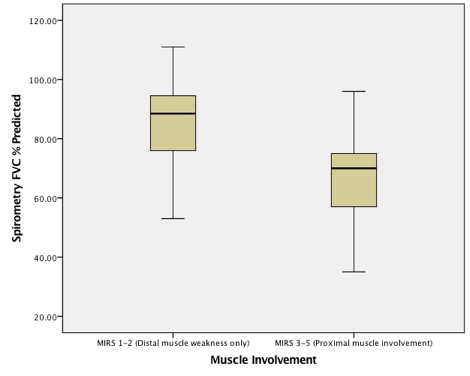Session Information
Date: Saturday, October 6, 2018
Session Title: Pathophysiology (Other Movement Disorders)
Session Time: 1:45pm-3:15pm
Location: Hall 3FG
Objective: This study aims to assess the association between CTG repeats, muscle weakness and respiratory dysfunction in a cohort of individuals with myotonic dystrophy type 1.
Background: Myotonic dystrophy Type 1 (DM1) is an autosomal dominant condition that causes muscle weakness as well as multisystem involvement, including respiratory dysfunction. The genetic basis for the condition is a CTG triplet repeat in the 3′ non-coding region of the DMPK gene. The relationship between the length of CTG repeats and severity of disease has not been well characterised.
Methods: 37 DM1 patients were prospectively evaluated for muscle weakness and rated using the Muscular Impairment Rating Scale (MIRS)(1). The participants then underwent respiratory function testing and genetic testing including CTG repeat length.
Results: Mean age 43.9 ± 13.6 years, 57% male. Mean time since diagnosis was 19.55 ± 10.3 years. Mean number of CTG repeats 553.6 ± 353.61 (n=28). 8 participants had a MIRS grade of II, 11 had a grade of III, 17 with a grade of IV and 1 with a grade of V. Mean forced vital capacity % predicted (FVC%) was 71.4% and mean forced expiratory volume in one second % predicted (FEV1%) was 72.9%. Participants with proximal muscle involvement (MIRS grade of III or greater) had a lower FVC% (Z=-2.345, p=0.019), FEV1% (Z=-2.547, p=0.011), Total Lung Capacity % predicted (TLC%) (Z=-2.228, p=0.026), Vital Capacity % predicted (VC%) (Z=-2.357, p=0.018), Peak expiratory flow % predicted (PEF%) (Z=-2.565, p=0.010), Maximal Inspiratory Pressure % predicted (MIP%) (Z=-2.498, p=0.012) and maximal expiratory pressure % predicted (MEP%) (Z=-3.030, p=0.002). A weak correlation between CTG repeat length and MEP% was found (Spearman’s rank correlation coefficient -0.409, p=0.04). There was no other statistically significant relationship between CTG repeat length and any respiratory function values nor muscle weakness.
Conclusions: The findings of this study indicate that muscle weakness involving proximal muscle groups is associated with more severe respiratory dysfunction. This is consistent with the accepted progression of the disease from distal to proximal muscle involvement. This study found no relationship between CTG repeat length and respiratory dysfunction nor muscle weakness.
References: 1. Mathieu J, Boivin H, Meunier D, Gaudreault M, Begin P. Assessment of a disease-specific muscular impairment rating scale in myotonic dystrophy. Neurology. 2001;56(3):336-340.
To cite this abstract in AMA style:
A. Hawkins, K. Abdul Razak, T. Khoo, K. Tran, R. Jackson. Relationship between CTG repeats, Muscle Weakness and Respiratory Dysfunction in Myotonic Dystrophy Type 1 [abstract]. Mov Disord. 2018; 33 (suppl 2). https://www.mdsabstracts.org/abstract/relationship-between-ctg-repeats-muscle-weakness-and-respiratory-dysfunction-in-myotonic-dystrophy-type-1/. Accessed December 14, 2025.« Back to 2018 International Congress
MDS Abstracts - https://www.mdsabstracts.org/abstract/relationship-between-ctg-repeats-muscle-weakness-and-respiratory-dysfunction-in-myotonic-dystrophy-type-1/

